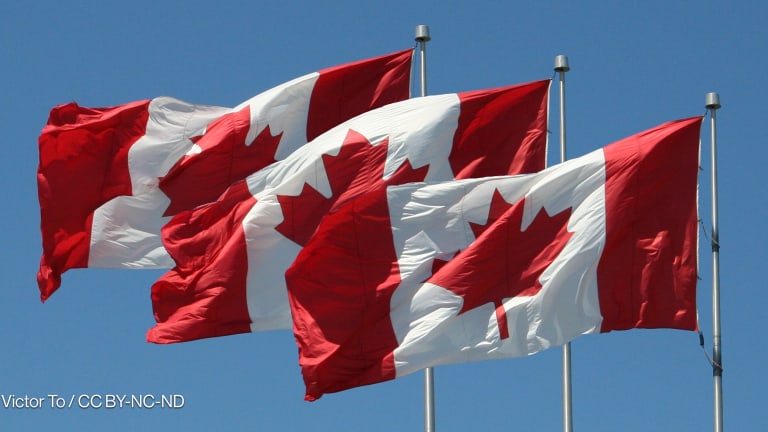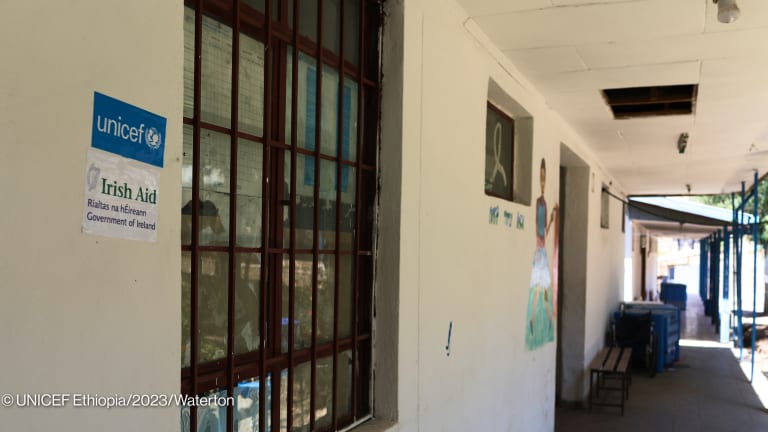Australian aid: A primer
Continuing our series of primers on English-speaking donors, Devex now examines how Australia does aid — from its geographical focus to where its priorities lie.
Sixty years after joining the Development Assistance Committee, Australia has spent tens of billions on economic, development, and humanitarian projects across the world. Its foreign cooperation is guided by four central themes: climate action; disability equity and rights; gender equality; and humanitarian action. Australia has also identified the Indo-Pacific region as a strategic focus, allocating about three-quarters of its projected 5.1 billion Australian dollars development aid for 2025 to 2026 to the region — likely equivalent to around 3.3 billion in U.S. dollars — according to its latest budget. In this article, we crunched the latest figures from the Organisation for Economic Co-operation and Development to better understand Australian aid — looking into the overall trends, top recipient countries, and priority sectors. We also examined the latest contracts from the Department of Foreign Affairs and Trade — Australia’s main aid funder — to list its lead implementers. All figures from OECD are in 2023 U.S. dollar constant prices. Top-level data Australia was the 13th-largest donor among the Development Assistance Committee member countries by volume in 2023, with a total aid spending of $3.3 billion. This represents 0.19% of the bilateral donor’s gross national income, which is below the DAC average of 0.37% and the U.N. target of 0.7% ODA-to-GNI ratio. Australia’s ODA spending in recent years has barely changed, staying around the $3 billion mark. But its ODA-to-GNI saw a steady decline, reaching 0.19% in 2023 versus the 0.22% in 2019. OECD’s preliminary data for 2024 shows that Australia’s ODA is currently worth $3.3 billion, or 0.19% of its national income — the same levels, in real terms, as 2023. Between 2019 and 2023, 82.6% of Australian aid was disbursed bilaterally, while the rest went to the multilateral system as core contributions. In 2023, Australia’s bilateral aid was worth $2.7 billion, while its multilateral aid amounted to $533 million. Zooming into Australia’s bilateral aid As mentioned, neighboring countries have typically enjoyed higher aid allocation from Australia. In 2023, about $2.2 billion, or 90.9% of the donor’s total bilateral aid, went to countries in Oceania and Asia. Among them, Papua New Guinea was the overall top recipient, with $420.5 million, or 15.5% of the total bilateral aid. Indonesia followed, with $218 million; then Solomon Islands, with $107.5 million; Fiji, with $104.8 million; and Myanmar, with $100.9 million. All of Australia’s top 20 recipient countries are in Oceania and Asia. Australia also spent $427.5 million, or 15.7% of its bilateral aid, on projects with multiple recipient countries from different regions, which OECD labels as “developing country, unspecified.” <div class='tableauPlaceholder' id='viz1753601822369' style='position: relative'><noscript><a href='#'><img alt='Australian aid geographical distribution in 2023 ' src='https://public.tableau.com/static/images/Au/Australianaidgeographicaldistributionin2023/Australianaidgeographicaldistributionin2023/1_rss.png' style='border: none' /></a></noscript><object class='tableauViz' style='display:none;'><param name='host_url' value='https%3A%2F%2Fpublic.tableau.com%2F' /> <param name='embed_code_version' value='3' /> <param name='site_root' value='' /><param name='name' value='Australianaidgeographicaldistributionin2023/Australianaidgeographicaldistributionin2023' /><param name='tabs' value='no' /><param name='toolbar' value='yes' /><param name='static_image' value='https://public.tableau.com/static/images/Au/Australianaidgeographicaldistributionin2023/Australianaidgeographicaldistributionin2023/1.png' /> <param name='animate_transition' value='yes' /><param name='display_static_image' value='yes' /><param name='display_spinner' value='yes' /><param name='display_overlay' value='yes' /><param name='display_count' value='yes' /><param name='language' value='en-US' /><param name='filter' value='publish=yes' /><param name='device' value='desktop' /><param name='showShareOptions' value='false' /> </object></div> <script type='text/javascript'> var divElement = document.getElementById('viz1753601822369'); var vizElement = divElement.getElementsByTagName('object')[0]; if ( divElement.offsetWidth > 800 ) { vizElement.style.width='950px';vizElement.style.height='577px';} else if ( divElement.offsetWidth > 500 ) { vizElement.style.width='950px';vizElement.style.height='577px';} else { vizElement.style.width='100%';vizElement.style.height='727px';} var scriptElement = document.createElement('script'); scriptElement.src = 'https://public.tableau.com/javascripts/api/viz_v1.js'; vizElement.parentNode.insertBefore(scriptElement, vizElement); </script> <i style=font-style: georgia;”>Geographical distribution of Australia’s bilateral ODA in 2023, based on OECD data.</i> By sector, a sizable portion of Australian aid, worth $278.2 million, or 10.2% of the bilateral aid in 2023, went to multisectoral activities. The largest individual sector was training and education, which received $192.3 million. Another priority was material relief assistance, an area under humanitarian aid, which got $181.5 million. Public sector policy and administrative management ranked next, with $92.5 million, then general budget support, with $89.2 million, and COVID-19 control — which refers to post-pandemic socioeconomic projects — with $88.7 million. <div class='tableauPlaceholder' id='viz1753602161611' style='position: relative'><noscript><a href='#'><img alt='Australian aid sectoral distribution in 2023 ' src='https://public.tableau.com/static/images/Au/Australianaidsectoraldistributionin2023/Australianaidsectoraldistributionin2023/1_rss.png' style='border: none' /></a></noscript><object class='tableauViz' style='display:none;'><param name='host_url' value='https%3A%2F%2Fpublic.tableau.com%2F' /> <param name='embed_code_version' value='3' /> <param name='site_root' value='' /><param name='name' value='Australianaidsectoraldistributionin2023/Australianaidsectoraldistributionin2023' /><param name='tabs' value='no' /><param name='toolbar' value='yes' /><param name='static_image' value='https://public.tableau.com/static/images/Au/Australianaidsectoraldistributionin2023/Australianaidsectoraldistributionin2023/1.png' /> <param name='animate_transition' value='yes' /><param name='display_static_image' value='yes' /><param name='display_spinner' value='yes' /><param name='display_overlay' value='yes' /><param name='display_count' value='yes' /><param name='language' value='en-US' /><param name='filter' value='publish=yes' /><param name='device' value='desktop' /><param name='showShareOptions' value='false' /> </object></div> <script type='text/javascript'> var divElement = document.getElementById('viz1753602161611'); var vizElement = divElement.getElementsByTagName('object')[0]; if ( divElement.offsetWidth > 800 ) { vizElement.style.width='950px';vizElement.style.height='587px';} else if ( divElement.offsetWidth > 500 ) { vizElement.style.width='950px';vizElement.style.height='587px';} else { vizElement.style.width='100%';vizElement.style.height='727px';} var scriptElement = document.createElement('script'); scriptElement.src = 'https://public.tableau.com/javascripts/api/viz_v1.js'; vizElement.parentNode.insertBefore(scriptElement, vizElement); </script> <i style=font-style: georgia;”>Sectoral distribution of Australia’s bilateral ODA in 2023, based on OECD data.</i> Support for the multilateral system OECD only shares data on gross disbursements to multilaterals, as opposed to bilateral aid, which is reported as grant-equivalent disbursements — as is recommended for any granular evaluation of development aid. Based on our findings, more than a third of Australia’s core contributions in 2023, worth $204.1 million, went to the International Bank for Reconstruction and Development, the lending arm of the World Bank that is focused on middle-income countries. The Asian Development Fund, the Asian Development Bank’s grant fund for lower-income member countries, was the second-largest recipient, with $81.9 million. Then the U.N. Secretariat, with $30.3 million; vaccine alliance Gavi, with $28.8 million; and the World Food Programme, with $26.6 million. Australia contributed to nearly 40 multilateral agencies and funds in 2023. Key players in Australian aid The Department of Foreign Affairs and Trade is Australia’s lead agency for development programming. It is also responsible for the country’s overall foreign policy. Based on our review of its latest data, the agency awarded almost 400 contracts in 2024, worth AU$1.3 billion ($869.7 million in 2024 prices) to over 130 suppliers and individual consultants. More than 90% of this, worth AU$1.2 billion, went to Australian suppliers. This included affiliates and offices of international organizations, such as the overall top three awardees: Palladium, Tetra Tech, and DT Global. A further AU$59.7 million went to U.S.-based recipients, while AU$57.8 million went to their Canadian counterparts. A portion also went to awardees, mostly consultants, in low- and middle-income countries, such as Vietnam, with AU$419,605; Thailand, with AU$223,650; and Nepal, with AU$148,522. Nearly 30% of the total awarded contracts in 2024, worth AU$390.7 million for 26 contracts, went to Palladium. The biggest of which, worth AU$170.1 million, is for the implementation of a labor mobility program in Pacific island countries and East Timor. Tetra Tech ranked next, with AU$181.8 million for eight contracts. Of this, AU$105.6 million is for the second phase of Australia Assists, a flagship program mobilizing humanitarian specialists for better disaster and conflict response and recovery. Third was DT Global, with AU$117 million for 16 contracts. The biggest, worth AU$77 million, is for the implementation of the Climate-Resilient Communities Support Unit, a five-year program that will support the cofunding and design of new climate change programming in the Asia-Pacific region. <div class='tableauPlaceholder' id='viz1753596724779' style='position: relative'><noscript><a href='#'><img alt='Dashboard 1 ' src='https://public.tableau.com/static/images/DF/DFATAustraliatopcontractorsin2024/Dashboard1/1_rss.png' style='border: none' /></a></noscript><object class='tableauViz' style='display:none;'><param name='host_url' value='https%3A%2F%2Fpublic.tableau.com%2F' /> <param name='embed_code_version' value='3' /> <param name='site_root' value='' /><param name='name' value='DFATAustraliatopcontractorsin2024/Dashboard1' /><param name='tabs' value='no' /><param name='toolbar' value='yes' /><param name='static_image' value='https://public.tableau.com/static/images/DF/DFATAustraliatopcontractorsin2024/Dashboard1/1.png' /> <param name='animate_transition' value='yes' /><param name='display_static_image' value='yes' /><param name='display_spinner' value='yes' /><param name='display_overlay' value='yes' /><param name='display_count' value='yes' /><param name='language' value='en-US' /><param name='filter' value='publish=yes' /><param name='device' value='desktop' /><param name='showShareOptions' value='false' /> </object></div> <script type='text/javascript'> var divElement = document.getElementById('viz1753596724779'); var vizElement = divElement.getElementsByTagName('object')[0]; if ( divElement.offsetWidth > 800 ) { vizElement.style.width='950px';vizElement.style.height='477px';} else if ( divElement.offsetWidth > 500 ) { vizElement.style.width='950px';vizElement.style.height='477px';} else { vizElement.style.width='100%';vizElement.style.height='727px';} var scriptElement = document.createElement('script'); scriptElement.src = 'https://public.tableau.com/javascripts/api/viz_v1.js'; vizElement.parentNode.insertBefore(scriptElement, vizElement); </script> <i style=font-style: georgia;”>DFAT Australia’s top contractors in 2024, based on its portal.</i> Other top suppliers are the Boston Consulting Group and Johnstaff International Development, which both received AU$99 million; Manta Ray Technology Solutions, with AU$59.7 million, and Adam Smith International, with AU$58.3 million. Try out Devex Pro Funding today with a free five-day trial, and explore funding opportunities from over 850 sources in addition to our analysis and news content.
Sixty years after joining the Development Assistance Committee, Australia has spent tens of billions on economic, development, and humanitarian projects across the world.
Its foreign cooperation is guided by four central themes: climate action; disability equity and rights; gender equality; and humanitarian action. Australia has also identified the Indo-Pacific region as a strategic focus, allocating about three-quarters of its projected 5.1 billion Australian dollars development aid for 2025 to 2026 to the region — likely equivalent to around 3.3 billion in U.S. dollars — according to its latest budget.
In this article, we crunched the latest figures from the Organisation for Economic Co-operation and Development to better understand Australian aid — looking into the overall trends, top recipient countries, and priority sectors. We also examined the latest contracts from the Department of Foreign Affairs and Trade — Australia’s main aid funder — to list its lead implementers.
This story is forDevex Promembers
Unlock this story now with a 15-day free trial of Devex Pro.
With a Devex Pro subscription you'll get access to deeper analysis and exclusive insights from our reporters and analysts.
Start my free trialRequest a group subscription Printing articles to share with others is a breach of our terms and conditions and copyright policy. Please use the sharing options on the left side of the article. Devex Pro members may share up to 10 articles per month using the Pro share tool ( ).
Miguel Tamonan is a Senior Development Analyst at Devex, where he analyzes data from public and private donors to produce content and special reports for Pro and Pro Funding readers. He has a bachelor’s degree in Political Science with a Major in International Relations from the Polytechnic University of the Philippines.








